At the end of 2020, the volume of the US government debt will amount to 98% of GDP.
This is stated in the report of the US Congressional Budget Office.
According to the ministry's forecast, in 2021 the indicator may reach 104% of GDP, in 2023 - 107%, and by 2050 the value will grow to 195%.
Thus, over the next 30 years, the debt of the American government will almost double the size of the country's economy.
To date, the US national debt is at its highest level for the entire time of observation - $ 26.8 trillion.
Since the beginning of 2020, the debt burden of the United States has grown immediately by $ 3.6 trillion, although before the figure increased by no more than $ 1.5 trillion a year.
Such data are provided by the Ministry of Finance of the country.
Analysts interviewed by RT attribute the record growth of the national debt to the growing spending by the American authorities on eliminating the consequences of the COVID-19 pandemic.
At the moment, the United States remains the leader in the number of people infected with coronavirus.
At the same time, the quarantine restrictions introduced in spring led to a massive reduction in trade and passenger traffic, as well as the closure of enterprises.
As a result, from April to June 2020, the GDP of the United States decreased by 31.7% at once compared to the same period in 2019.
This is stated in the materials of the Bureau of Economic Analysis of the US Department of Commerce.
“The weakening of business activity led to an economic downturn, which led to a decrease in the volume of budget revenues.
The unprecedented multibillion-dollar increase in the costs of supporting and stimulating the economy affected even more negatively.
This "double blow" resulted in a rapid increase in the budget deficit.
In these conditions, the most accessible and customary way to cover costs is to increase borrowing, ”said Mark Goikhman, chief analyst at TeleTrade, to RT.
The US authorities estimate that the US budget deficit will more than triple in 2020, to 16% of GDP, the highest level since 1945.
In 2027, the indicator will return to the pre-crisis level (4%), after which it will begin to grow again and in 2050 will reach 13%.
“It should be borne in mind that from 2035 in the United States will increase the problem of the budget deficit of the pension fund.
By this time, the fund should have eaten up the available assets.
Thus, Americans will have to do something about the pension system.
The authorities may even decide to lower pensions or revise the retirement age, "said Alexander Abramov, head of the laboratory at the Institute of Applied Economic Research of the RANEPA, in an interview with RT.
Paper cargo
Note that to cover the budget deficit, the US Treasury Department issues special treasury bonds (Treasuries).
American and foreign investors buy securities and receive a stable income on them, in fact, lending their money to the American economy.
These funds are used to pay off the budget deficit, but in the long term, the growth of public debt only increases the burden on the country's budget.
“The national debt puts enormous pressure on the economy.
To maintain it, more and more resources are needed.
These payments for such increased borrowings are also additionally borne by the budget.
There is a need for new loans, and a vicious circle is created.
Thus, the debt burden restrains economic growth and at the same time increases the risks of crisis phenomena in the financial sector, ”said Mark Goykhman.
US Federal Reserve Building in Washington
Reuters
© Kevin Lamarque
It is noteworthy that lately, keeping money in American government securities has become less and less profitable for foreign investors.
Experts interviewed by RT associate this state of affairs with the policy of the US Federal Reserve System (analogue of the Central Bank).
The yield on Treasury bonds directly depends on the interest rate set in the country.
Meanwhile, since the beginning of 2020, the US Federal Reserve has cut the rate from 1.5-1.7% to 0-0.25% per annum.
The regulator pursues such a policy to stimulate the economy - loans become cheaper, and business and consumer activity begins to grow.
At the same time, the Fed's actions make investments in Treasuries less profitable.
Against this backdrop, in the spring, the Fed announced an unprecedented expansion of the quantitative easing program.
The regulator began printing dollars and buying up treasuries on the stock market in an unlimited amount.
So, over the past six months, the volume of treasury bonds on the Fed's balance sheet has grown from $ 4.2 trillion to $ 7.06 trillion.
“Obviously, zero rates in the US will persist for a long time.
The head of the FRS, Jerome Powell, spoke directly about this.
Therefore, the country's financial authorities have no choice but to pump the economy with liquidity.
Thus, the United States follows the Japanese scenario of zero rates and money printing.
Japan has been living this way for over ten years.
At the same time, the States are actively increasing the country's budget spending, in particular, on the defense industry, ”Ivan Kapustyansky, a leading analyst at Forex Optimum, told RT.
Reuters
© Dado Ruvic
According to Alexander Abramov, in the long term, the policy of printing money runs the risk of accelerating inflation and weakening the dollar on the international market.
At the same time, a simultaneous increase in the debt burden may disrupt the stability of the US financial system.
“The increase in the national debt can lead to problems with its financing. Subsequently, the authorities will have to raise taxes, and this will painfully affect the population. Social benefits are also likely to decrease. The experience of Japan, Greece and Italy suggests that a large national debt risks turning into an outflow of investment, as well as a decline in consumption and a slowdown in economic growth, "Abramov concluded.

